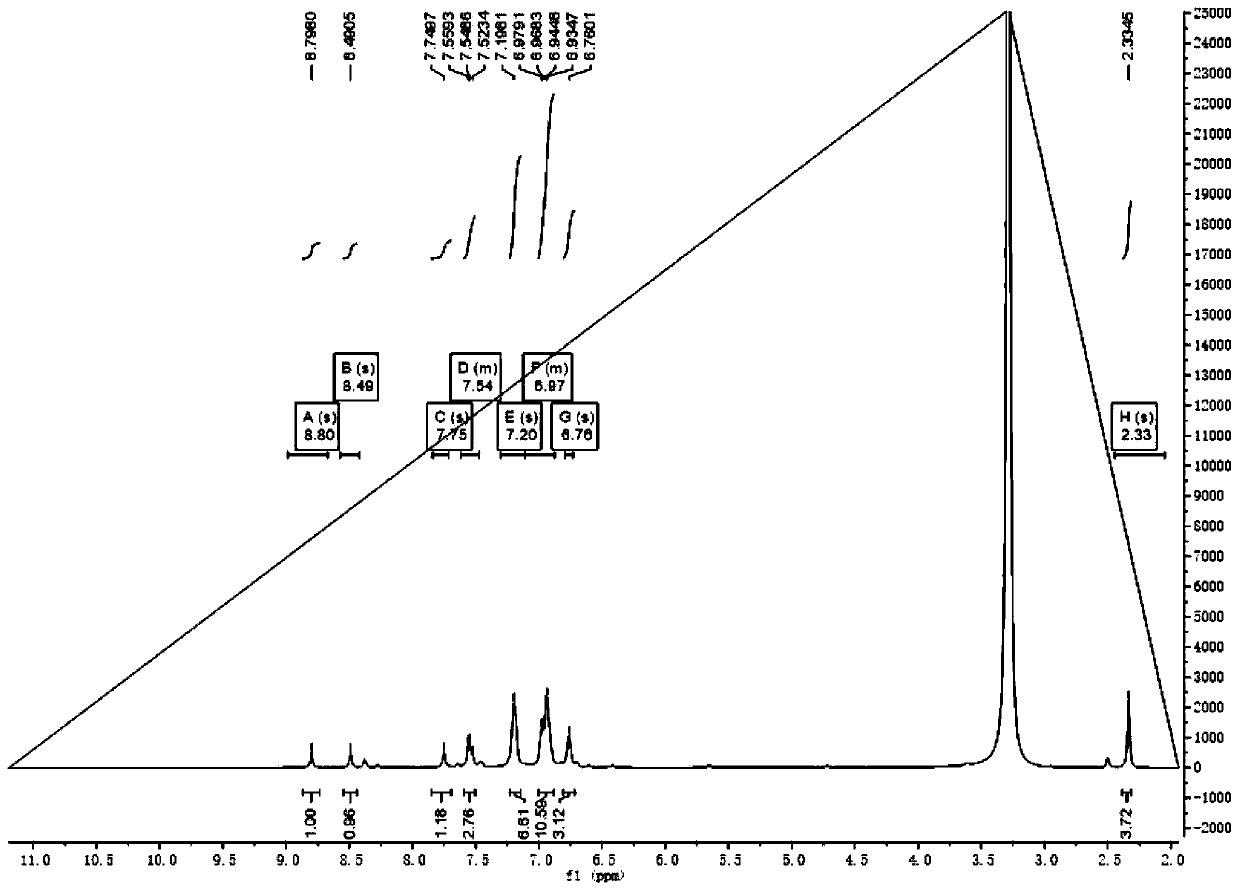Small-molecule fluorescent probe, and preparation method and application thereof
A technology of fluorescent probes and small molecules, which is applied in the fields of fluorescence/phosphorescence, chemical instruments and methods, and analytical materials, and can solve problems such as unsatisfactory recognition ability and selectivity, and few reports on dual-functional recognition probes. Achieve the effect of good application prospect, simple synthesis method and convenient operation
- Summary
- Abstract
- Description
- Claims
- Application Information
AI Technical Summary
Problems solved by technology
Method used
Image
Examples
Embodiment 1
[0029] Example 1 Synthesis of Small Molecular Probes
[0030] Dissolve triphenylamine oxime (0.238g, 0.83mmol) and spiropyranaldehyde (0.300g, 0.83mmol) in 30mL ethanol solution, wherein triphenylamine oxime and spiropyranaldehyde are customized by Anaiji Chemical, and the structural formula is as follows figure 1 shown in , and stirred at room temperature for 16 hours to obtain a light yellow precipitate; the above light yellow precipitate was filtered, washed repeatedly with ethanol, and dried to obtain 0.183g of a yellow solid powder, abbreviated as SPTPA, with a yield of 35%. And mass spectrometry can confirm that the product is the target small molecule probe. The route for the synthesis of small molecule probes is figure 1 , figure 1 Represents the roadmap for the synthesis of small molecule fluorescent probes, where EtOH is ethanol and RT is room temperature.
[0031] NMR characterized as figure 2 , the mass spectrum is characterized by image 3 And the model of t...
Embodiment 2
[0036] Example 2 Ultraviolet and Fluorescent Spectrum of Small Molecular Probes Recognizing Hypochlorous Acid
[0037] Prepare 1 mL of small molecule probes (10 µM and 2.0 µM) in DMSO / HO 2 O (v / v=5:1) solution. The same concentration of ClO - The solution was added dropwise to the probe solution,
[0038] Such as Figure 5 As shown in (a), adding ClO to the probe solution - Afterwards, the absorption bands at 298nm and 408nm gradually decrease, and there is a new absorption peak at 350nm~600nm, and the maximum absorption peak appears at 530nm, and its absorption intensity varies with ClO- The concentration was increased and gradually increased, and finally the stoichiometric ratio of the two was 1:3. For fluorescence titration experiments, prepare 1 mL of small molecule probes (2.0 μM) in DMSO / HO 2 O (v / v=5:1) solution. The same concentration of ClO - The solution was added dropwise to the probe solution, and the fluorescence value of the probe from 400nm to 700nm was m...
Embodiment 3
[0039] Example 3 verifies the selectivity and competitiveness of small molecule probes to hypochlorous acid.
[0040] Prepare 5.0mL molecular probe (5.0×10 -6 mol / L) of DMSO / H 2 O (v / v=1:1) solution. Solutions of various anions were prepared by dissolving the corresponding salts in deionized water [F - , Cl - , NO 2 - , ClO 4 - , HCO 3 - , H 2 PO 4 - , SO 4 2- , S 2 o 3 2- , CO 3 - , H 2 o 2 ,ClO - ](1.0×10 -3 mol / L). Subsequently, an equivalent equivalent of the anion solution was added to the probe solution. Detection is carried out by fluorescence spectroscopy, the experimental results are shown in Figure 10 (a). Take the fluorescence maximum absorption wavelength for comparison, such as Figure 10 As shown in (b), the ions include F - , Cl - , NO 2 - , ClO 4 - , HCO 3 - , H 2 PO 4 - , SO 4 2- , S 2 o 3 2- , CO 3 - , H 2 o 2 , ClO - . Except for hypochlorite ion, none of these anions produced significant changes in the fluor...
PUM
 Login to View More
Login to View More Abstract
Description
Claims
Application Information
 Login to View More
Login to View More - R&D
- Intellectual Property
- Life Sciences
- Materials
- Tech Scout
- Unparalleled Data Quality
- Higher Quality Content
- 60% Fewer Hallucinations
Browse by: Latest US Patents, China's latest patents, Technical Efficacy Thesaurus, Application Domain, Technology Topic, Popular Technical Reports.
© 2025 PatSnap. All rights reserved.Legal|Privacy policy|Modern Slavery Act Transparency Statement|Sitemap|About US| Contact US: help@patsnap.com



